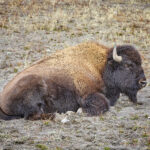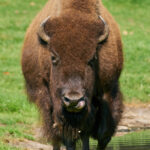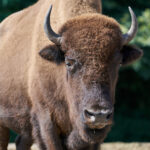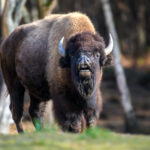Definition of Sleep in Bison
Sleep in bison can be defined as a naturally recurring state of reduced consciousness and decreased physical activity. During sleep, bison experience periods of rest, enhanced hormonal regulation, and mental rejuvenation, which are vital for their overall well-being.
Types of Sleep in Bison
Bison experience two main types of sleep: slow-wave sleep (SWS) and rapid-eye-movement (REM) sleep. SWS is characterized by deep, non-dreaming sleep, during which the bison’s brain waves slow down significantly, and their body undergoes physiological restoration. REM sleep, on the other hand, is associated with vivid dreaming, rapid eye movements, and increased brain activity.
Average Sleep Duration in Bison
On average, bison sleep for around four to six hours per day. However, sleep patterns can vary depending on various factors such as age, season, and environmental conditions. During periods of intense heat or cold, bison may alter their sleep patterns to adapt and ensure their survival.
Sleep Positions of Bison
Various Sleep Positions
Bison exhibit several sleep positions, including lateral lying down, standing, and sometimes even sitting. These positions allow them to rest and sleep while remaining alert to potential threats in their surroundings.
Details about the Lateral Sleep Position
The lateral sleep position is the most commonly observed sleep position in bison. In this position, the bison lies down on its side, with its legs folded beneath its body. This position provides the bison with stability and allows for quick and efficient movement if needed.
Details about the Standing Sleep Position
Bison can also sleep while standing, especially when they feel threatened or in open areas where predators may be present. In this position, they balance on their four legs, with their heads lowered and their eyes closed or half-closed. This sleeping posture enables bison to maintain vigilance and react promptly to any potential danger.
Impact of Bison’s Habitat on Sleep
Effect of Weather and Seasons on Bison Sleep
Bison’s sleep patterns can be influenced by weather and seasonal changes. During hot summer months, bison may rest more during the day to avoid excessive heat, seeking shelter in shady areas. In colder seasons, they may conserve energy by reducing their sleep duration and frequently shifting between different sleep positions to stay warm.
Effect of Predatory Threats on Bison Sleep
The presence of predatory threats, such as wolves or bears, can significantly impact bison’s sleep behavior. Bison are acutely aware of their surroundings and often adapt their sleep patterns to ensure they remain alert and ready to flee or defend themselves if necessary. They may sleep less deeply and adopt a standing sleep position when they perceive an increased risk of predation.
Influence of Grazing and Feeding Habits on Bison Sleep
Bison’s sleep patterns are also influenced by their feeding habits. As herbivores, they spend a significant amount of time grazing and foraging for food. This activity is typically prioritized oversleep, and bison may adjust their sleep duration and position accordingly to balance their energy requirements.
Sleep Patterns of Baby Bison
Newborn Bison’s Sleep Frequency
Newborn bison, known as calves, have different sleep patterns compared to adult bison. Calves require more sleep for growth and development, and therefore sleep more frequently throughout the day. They often nap for short periods of time, both standing and lying down, before nursing and engaging in playful activities.
Transition in Sleep Patterns with Age
As baby bison grow older, their sleep patterns gradually transition to resemble those of adult bison. The number of hours they sleep decreases, and they begin to adopt similar sleep positions. However, the presence of their mother remains crucial in regulating their sleep, providing comfort and protection.
Role of Mother Bison in Sleep Regulation
Mother bison play a crucial role in regulating the sleep patterns of their offspring. They create a sense of security for their calves, enabling them to sleep peacefully. The mothers often remain in close proximity to their young during sleep, ensuring their safety and intervening if any potential threats arise.
Significance of Sleep for Bison Health
Healing and Restoration through Sleep
Sleep is essential for bison to heal and restore their bodies. During sleep, their muscles relax, and their tissues and organs undergo repair and regeneration processes. This allows bison to recover from physical exertion, injuries, and ensure optimal functioning of their bodily systems.
Energy Conservation and Sleep
Sleep aids in energy conservation for bison. By reducing physical activity and metabolic rates during sleep, bison can conserve energy to sustain themselves throughout the day. This is particularly crucial during times when food sources may be scarce or when extreme weather conditions limit their ability to graze.
Sleep Deprivation and Potential Effects on Bison Health
Sleep deprivation can have detrimental effects on bison’s health. Just like humans, a lack of sufficient sleep in bison can lead to fatigue, decreased immune function, impaired physical performance, and increased vulnerability to stress and diseases. It is therefore crucial for bison to obtain adequate sleep for their overall well-being.
Comparison of Bison Sleep with Other Herbivores
Similarities in Sleep Habits with Other Herbivores
Bison share some sleep habits with other herbivores. Like many herbivorous animals, they typically sleep for shorter durations compared to carnivores or omnivores, focusing more on feeding and social interactions. Herbivores, including bison, also tend to adopt a standing or lateral sleep position to remain alert to potential dangers while they rest.
Differences in Sleep Habits with Other Herbivores
Despite some similarities, there are also notable differences in sleep habits among herbivores. For example, bison may exhibit more pronounced vigilance during sleep due to their size and vulnerability to predators. Additionally, the specific sleep durations and positions can vary depending on the species’ evolutionary adaptations and the unique factors of their respective habitats.
Reasons behind Varying Sleep Patterns
The varying sleep patterns among herbivores can be attributed to a combination of factors, including evolutionary history, ecological niche, and environmental conditions. Each herbivorous species has developed specific sleep patterns to ensure their survival, such as balancing the need to graze for food, avoiding predation, and recovering from physical exertion.
Adaptations for Sleep in the Wild
Predator Awareness during Sleep
To ensure their safety, bison have developed adaptations for sleep in the wild. Even during sleep, they remain alert to their surroundings, using their keen senses, including hearing and smell, to detect any potential threats or approaching predators. This heightened predator awareness allows them to respond quickly and appropriately to any danger.
Quick Wakefulness and Alertness
Bison have the ability to awaken quickly from sleep and become alert in response to any potential danger. This adaptive trait enables them to rapidly assess the situation and respond accordingly. The quick wakefulness of bison contributes to their survival in the wild, where they must remain vigilant to withstand the challenges of their environment.
Herd Formation during Sleep
Bison also exhibit the behavior of forming close-knit herds, even during sleep, which provides additional protection and security. By sleeping in proximity to other herd members, bison can collectively watch out for each other and rely on the strength of numbers to deter predators or detect any impending danger.
Did the Decline of Bison Population in the Late 1800s Affect Their Sleep Patterns?
The bison population decline in the late 1800s had potentially affected the sleep patterns of these magnificent creatures. As their numbers dwindled due to excessive hunting and habitat loss, bison likely faced increased stress and disturbances during their slumber, impacting their natural sleep patterns and behaviors. Understanding the consequences of such a decline helps shed light on the broader ecological impacts caused by human activities.
Interpretation of Bison Sleep Behaviour
Signals Indicating a Sleeping Bison
Identifying a sleeping bison can be challenging, as they often remain motionless and exhibit minimal visible movement during sleep. However, some signals can indicate a sleeping bison, such as closed or half-closed eyes, relaxed body posture, and lack of responsiveness to external stimuli. Additionally, their chosen sleep position, be it lateral lying down or standing, can offer clues to their sleeping state.
Analysis of Changes in Sleep Behaviour
Changes in sleep behavior can signify various factors affecting bison, such as changes in environmental conditions, social dynamics within the herd, or potential disturbances. Observing alterations in sleep patterns or positions can provide insights into the overall well-being and adaptive strategies of bison.
Correlation between Sleep and Bison’s Body Language
The sleep behavior of bison can be closely linked to their body language and overall behavior. For example, a bison’s choice to sleep while standing may indicate a heightened state of alertness and increased suspicion of potential threats. By observing how sleep intertwines with their body language, researchers and observers can gain a deeper understanding of bison’s sleep patterns and their role in their survival strategies.
In conclusion, understanding the anatomy, characteristics, and sleep behaviors of bison is crucial for appreciating their adaptability and survival in the wild. Bison’s sleep patterns, positions, and adaptations highlight their ability to balance rest, safety, and energy conservation while thriving in their natural habitat. By delving into the intricacies of bison’s sleep, we gain valuable insights into the remarkable world of these magnificent creatures.










